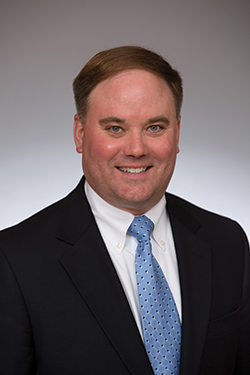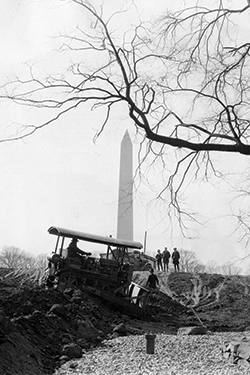
Chris Myers has been working in Washington, DC for more than 20 years. His first stint in Washington came when he was a student at Hillsdale College, interning for then-Vice President Dan Quayle. His Capitol Hill journey began in the Office of Congressman Phil Crane of Illinois, where he first served as a tax policy advisor and then became chief of staff. From there, Myers was a tax lobbyist for the U.S. Chamber of Commerce before joining Caterpillar’s government affairs team, where he currently serves as International & Federal Government Affairs Director. Myers sat down with iBi to discuss the ins and outs of Caterpillar’s government affairs: how the team operates, the company’s view on key issues and its hopes for the new administration.
Tell us more about Caterpillar’s government affairs team. To what degree does the team focus on the federal government vs. the state level? What about internationally?
Our largest government affairs office is in Washington DC, where I sit, but we have teams spread out around the world—from Springfield to Singapore, Beijing to Brazil, Japan to Georgia, Europe to the U.K., Mexico to Moscow, India to Indonesia and Texas to Thailand. I manage our team based in Washington, which has two sides. One side is the federal team, which works with Congress and the administration on their respective issues. Each team member has a portfolio of issues, which they cover working with the House and Senate, the White House and governmental agencies. The other side is the international advocacy team, and a lot of their work is focused on the U.S. State Department, embassies and the Department of Commerce. They work closely with each government affairs team globally and team up with them on key issues. Then there is a state government affairs team with representatives in key regions helping our facilities—and often, our dealers—navigate issues important to our success.
What is your typical day like?
There is no typical day… typically. Each day varies. We kick off each week with Monday morning meetings with our internal team at Caterpillar, catching up with our media and state government affairs teams to monitor key issues across the country. We’ll compare notes on different events happening throughout the week. During the rest of the week, we’re running between meetings with key people on Capitol Hill, who we see on a regular basis. Many of these meetings are with business allies, and even some of our marketplace competitors. A lot of this work is focused on issue-specific coalitions, including tax reform, immigration reform, infrastructure, road building, highway bills and so on. By coordinating with others in the business community and working with lawmakers and their staff, we ensure our views are represented, and we’re amplifying the voice of Caterpillar with other industry partners. We work closely with major trade associations as well, including the Business Roundtable, National Association of Manufacturers, U.S. Chamber of Commerce, Association of Equipment Manufacturers and National Mining Association, to name a few. We have an executive officer serving on the board of each of these important associations.
 Describe the nature of your advocacy efforts with Congress.
Describe the nature of your advocacy efforts with Congress.
When we’re working on any particular issue, which usually takes a while to work its way through Congress, we’ll have a series of meetings with lawmakers. The discussions may start out meeting with the Congressman’s staff to tee up the issue as one of concern or as an important priority for Caterpillar. Depending on the significance of the issue, I’ll have a follow-up meeting with a member of Congress and one of Caterpillar’s executives. The timing of these meetings aligns with when the bill gets closer to some action or, in particular, a vote.
Much of what we do is storytelling—explaining how our colleagues at Caterpillar do their jobs and how we operate as a business and major employer in Illinois, the U.S. and around the world. For example, when we discuss the importance of trade and access to global markets, we tell them we exported about 80 percent of products made in our Decatur plant in 2015—and 70 percent of large tractors made in East Peoria went to customers outside U.S. borders in 2015. It’s a compelling argument for free trade.
The incoming administration has stated its desire for a large transportation infrastructure bill. What are the primary elements that should be included?
As you can imagine, we are spending a lot of time on this. There are two key components to the infrastructure issue. One is the spending component, which is easier to define, since it revolves around the need for infrastructure: repairing and improving existing infrastructure or expanding current infrastructure.
The second component—funding—is less defined. This has been a longstanding issue. We have a defined need, but the funding mechanism is primarily user fees, which are typically gas and fuel taxes. This has been a declining revenue source for years for a number of reasons.
Specifically, because of inflation and fuel efficiency, it is no longer a sustainable source of funding. We are focusing on where the funding would come from with lawmakers on Capitol Hill and the Trump Administration. We are looking at a long-term, sustainable solution to support these infrastructure priorities into the future. Going into the presidential election, we felt this issue would get a lot of attention, regardless of who won. While the details of what President-elect Trump has in mind for the infrastructure package remain to be seen, we know his team will be focused on it. Given his background, we think he certainly has a passion for this, and it will remain a priority for him.
How is Caterpillar focused on tax reform?
It has been 30 years since the last major tax reform—before the invention of the Internet. It's time for an upgrade. The tax code is very complicated and has a direct impact on Caterpillar’s competitiveness. You must work diligently to ensure it is done correctly, and we’ve been working on this for some time. Our executive officers have visited Washington frequently for this issue and even testified on Capitol Hill. While we’re making incremental improvements, like making the research-and-development tax credit a permanent feature of the tax code, we’re hoping 2017 brings comprehensive business tax reform. There’s interest from the Trump Administration and a lot of interest from Capitol Hill. In short, we are trying to get the business tax code right so it works for businesses of all types—not just for Caterpillar, but for dealers, suppliers and customers. If we get this right, it will open doors for significant growth.
How is Caterpillar an industry leader in terms of employee engagement for political advocacy?
Caterpillar is looked to as a leader in Washington when it comes to grassroots advocacy. Congressman Peter Roskam from Illinois regularly cites Caterpillar as the benchmark—one which other companies should follow in terms of employee engagement.
We alert employees to bills that are going to be voted on and encourage them to weigh in with their members of Congress. The pivotal piece is the member of Congress and their staff hearing a consistent narrative from every person at Caterpillar—from Caterpillar executives, our team in Washington and our employees, who are constituents and voters in their respective districts—through a flood of letters.
When we engage our employees, we’re typically sending in more letters—10 to 20 percent more—than any one trade association does with its entire membership. For example, when the U.S. Chamber or the National Association of Manufacturers has a big issue and they engage their members, letters usually trickle in until Caterpillar engages. It’s a testament to the passion of our employees.
How does Caterpillar work with its industry peers to provide a more complete view of the issues and their potential impact?
We work closely with business allies—other companies which are not necessarily in the same line of business but are similarly situated, being U.S.-headquartered with global operations. We’ll also work side by side with our marketplace competitors because the issues we’re working on have similar impact, whether on the positive side—trying to get a better tax code—or the negative side—trying to stop an onerous regulation that would hurt our ability to compete. We count on our first-in-class products to win in the marketplace, but in Washington, we’re partners for good policy.
The less-obvious benefit of collaborating with our industry peers is utilizing each other’s connections. For instance, if I’m meeting with an Illinois congressman, I can bring along our friends at other companies. While the congressman will have heard Caterpillar’s story, they can also learn the background on how an issue impacts these other companies. Likewise, if we need to talk to some folks in Georgia, for example, we’ll get in behind a company that everyone in the Georgia delegation knows. Amplifying our message is critical to getting movement on policy in Washington: the more hands on deck, the more influence we have in creating a pro-growth agenda. iBi

